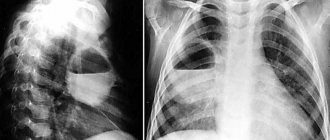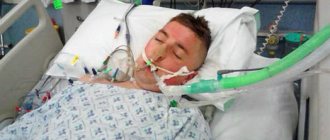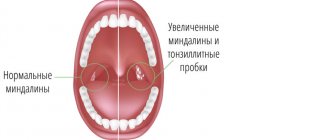Let's figure out what really helps and whether you need to take antibiotics right away for Covid-19
It is believed that the main threat from coronavirus is lung damage. How does covid infection occur, and at what point does the process become complicated by bacterial pneumonia? How to distinguish one from the other, is there a way to protect yourself in advance and prevent COVID-19 from turning into pneumonia, Vladimir Beketov, candidate of medical sciences, pulmonologist at Sechenov University, told kp.ru.
The first thing that is important to understand, the expert says, is that the new coronavirus infection is a viral infection and is included in the group of acute respiratory viral infections. The only thing that stands apart from this group is influenza. This means that COVID-19, like all respiratory viral infections that affect the upper respiratory tract and lungs, is characterized by the following phenomenon. Immune defenses in the lungs weaken. Therefore, it becomes possible for a secondary bacterial super-infection to occur approximately on the 5th – 9th day of the course of any acute respiratory viral disease.
“Since Covid is a special disease, and it does not progress as quickly as the flu, for example, the addition of a bacterial infection, as a rule, occurs with COVID-19 towards the end of the second week,” says pulmonologist Vladimir Beketov.
HOW PNEUMONIA DEVELOPES
In conditions of reduced respiratory and motor activity, when mucus moves less through the bronchi, against the background of intoxication of the body and decreased immunity, bacteria from the nasopharynx descend into the lower parts of the respiratory tract and can begin to multiply there.
Thus, bacterial bronchitis can be caused first, then bronchopneumonia with transition to pneumonia. The development of bacterial pneumonia can also be facilitated by the patient being on a ventilator for a long time. Despite compliance with all the strictest disinfection measures, ventilators are risk factors for the occurrence of ventilator-associated pneumonia.
Classification of antibiotics
All antibacterial agents can be divided into 5 categories according to their characteristics and range of application. Let's take a closer look at this classification:
Mechanism of action:
- Bactericidal - the active substances of the drugs completely destroy bacteria and viruses. After taking such strong drugs, all pathogenic microflora in the human body dies.
- Bacteriostatic – inhibits the growth or spread of viruses. Thus, the cells remain “alive” without forming pathogenic flora.
DOES PNEUMONIA REALLY FOLLOW COVID-19?
— Recently, an analysis of statistical data shows that the medical community is mistakenly addicted to antibiotics in the treatment of a new coronavirus infection, suggesting that changes in the lungs are immediately associated not only with the virus, but also with a bacterial component. This is not true, says pulmonologist Vladimir Beketov.
According to the expert, to date, a number of reputable medical associations have issued memorandums and open letters calling on colleagues to reduce the use of antibiotics during the treatment of COVID-19, because antibiotics do not provide benefit, but in this case cause harm, including toxic damage to the liver and development of antibiotic-associated diarrhea.
— That is, we seem to be trying to treat pneumonia, which in the doctor’s mind is strongly associated with bacteria, but in fact, at the stage, while there is no secondary pneumonia associated with Covid, we are only dealing with coronavirus lung damage, which is recommended not to be called pneumonia, and call it pneumonitis (inflammation of the vascular walls of the alveoli, as well as the tissue separating the alveoli from the lungs, which is accompanied by scarring - editor's note), says pulmonologist Vladimir Beketov.
The very phenomenon of secondary bacterial pneumonia due to coronavirus is overestimated, the expert continues. Such processes develop mainly in patients with heart failure, and for them there are increased precautions, restrictions on movement, recommendations for self-isolation and treatment at home.
- Smokers are also at risk for developing bacterial pneumonia. However, if smokers with COPD receive proper inhalation treatment and are vaccinated against pneumococcus, then their risks of secondary bacterial pneumonia are also minimized, says Vladimir Beketov.
Pneumonia - symptoms and treatment
Which doctor treats the disease?
Pneumonia is treated by a general practitioner or pulmonologist.
When to see a doctor
You should consult a doctor if you have trouble breathing, chest pain, persistent fever (above 38°C) and cough, especially with phlegm.
Indications for the disease
Treatment of patients with CAP is complex and is based on several basic principles:
- prescription of antimicrobial drugs;
- adequate respiratory support if necessary;
- use of non-antibacterial drugs (only if indicated);
- prevention of complications.
Timely detection and treatment of decompensation or exacerbation of concomitant diseases is extremely important, since their presence/severity can radically affect the course of pneumonia.[10]
Antimicrobials
Important! Antibacterial therapy (ABT) can only be prescribed by a doctor, otherwise the risk of drug resistance (resistance) of microorganisms increases sharply.
The main groups of antimicrobial drugs used in the treatment of pneumonia:
- beta-lactam antibiotics (penicillins and cephalosporins);
- macrolides;
- respiratory fluoroquinolones.
In some cases, if there are special indications, drugs from other groups (tetracyclines, aminoglycosides, lincosamides, vancomycin, linezolid) can be used.
For viral pneumonia (usually associated with influenza virus), neuraminidase inhibitors (oseltamivir and zanamivir), which are highly active against influenza A and B viruses, are of greatest importance.
When treating outpatients, preference is given to oral antibiotics (usually in tablet form). When treating patients in a hospital, a stepwise approach is used: they begin with parenteral administration of antibiotics (the intravenous route is preferable), then, as the patient is clinically stabilized, they are transferred to oral administration (tablets).
The duration of antimicrobial therapy for non-severe CAP is determined individually; for severe CAP of unspecified etiology, it lasts at least 10 days. Longer courses of ABT (from 14 to 21 days) are recommended only in case of the development of complications of the disease, the presence of foci of inflammation outside the lung tissue, infection with S.aureus, Legionella spp., non-fermenting microorganisms (P.aeruginosa).
In clinical practice, the decision about the possibility of stopping AMT at the right time is very important. For this purpose, sufficiency criteria have been developed:
- persistent decrease in body temperature < 37.2ºС for at least 48 hours;
- absence of manifestations of intoxication syndrome;
- normalization of respiratory rate (<20/min);
- absence of purulent sputum;
- decrease in the number of leukocytes in the blood (< 10·109/l), neutrophils (< 80%), young forms (< 6%);
- absence of negative dynamics on the radiograph.[3]
Respiratory support
Acute respiratory failure (ARF) is the leading cause of death in patients with CAP, so adequate respiratory support is an essential component of the treatment of such patients (in conjunction with systemic antibiotic therapy, of course). Respiratory support is indicated for all patients with CAP with PaO2 < 55 mmHg. or SpO2 < 88% (when breathing air).[4]
Oxygen therapy is carried out in case of moderate lack of oxygen in the blood using a simple nasal mask or a mask with a dispensing bag.
Artificial pulmonary ventilation (ALV) is used if, even with oxygen inhalation, the target level of blood oxygen saturation is not achieved.
Indications for mechanical ventilation for ARF due to CAP:
- absolute: respiratory arrest, disturbance of consciousness (stupor, coma), psychomotor agitation, unstable hemodynamics (system blood pressure < 70 mm Hg, heart rate < 50/min);
- relative: respiratory rate >35/min PaO2/FiO2 < 150 mm Hg, increase in PaCO2 > 20% of the initial level, impaired consciousness.
Non-antibacterial therapy
It is represented by three main classes of drugs:
- systemic glucocorticosteroids (GCS);
- intravenous immunoglobulins (IG);
- some immunostimulants.
Glucocorticosteroids
The issue of prescribing GCS is considered primarily in severe CAP, which is complicated by septic shock. GCS help limit the destructive effects of systemic inflammation through various genomic and non-genomic effects.
Immunoglobulins
The use of IG in the treatment of infections complicated by sepsis is based on a variety of effects: from neutralizing bacterial toxins to restoring cell reactivity during the phenomenon of “immune paralysis.”
In the treatment of sepsis, polyclonal IGs are most effective, reducing the relative risk of death compared to placebo. Routine use of intravenous IG in patients with severe CAP complicated by sepsis is inappropriate.
Immunostimulants
Interest in these drugs is associated with their ability to enhance phagocytosis, formation and maturation of neutrophils. However, due to the lack of a convincing evidence base, they are currently practically not used in routine practice.
Contraindications for illness
For pneumonia, self-medication is highly discouraged, especially with the use of antibiotics. Currently, there are many groups of antibacterial drugs; to select adequate therapy, the doctor will ask several questions about the history of the disease, drug intolerance, previous use of antibiotics and what other drugs the patient takes regularly. In the acute period of the disease, it is recommended to refrain from the active use of physiotherapeutic methods of treatment, especially those associated with heating the tissues.
Spectrum of action
There are antibacterial agents:
By composition
Antibacterial drugs are divided into 6 groups:
- Penicillins are the first antimicrobial drugs, obtained back in 1928 from a biological substance (Penicillium fungi). For a long time they remained the most popular medicine for the treatment of infectious diseases.
- Cephalosporins belong to the group of the most powerful antimicrobial agents with a wide range of applications. They completely destroy pathogenic flora and are well tolerated by humans.
- Macrolides are the name of a group of narrow-range antimicrobial agents. They do not destroy the diseased cell, but only stop its growth. This category includes the following drugs: erythromycin, spiramycin, azithromycin.
- Tetracyclines are good drugs for the treatment of infectious diseases of the respiratory and urinary tract.
- Fluoroquinolones are antimicrobial agents with a wide range of effects. Completely destroy pathogenic microorganisms. You can find 1st-2nd generation medications on sale. Doctors usually prescribe them to combat Pseudomonas aeruginosa.
- Aminoglycosides are antimicrobial drugs with a wide range of applications. Popular drugs in this group - streptomycin (therapy of tuberculosis, plague) and gentamicin - are used as ointments, eye drops, and injections for ophthalmic infections.
Generations of drugs. Advanced antimicrobial drugs already have six generations. For example, penicillin was the first drug of natural origin, while the third or sixth generation is an already improved version, which includes the strongest inhibitors. The relationship is direct: the newer the generation, the more effective the effect of drugs on pathogenic microflora.
By method of administration. Oral – taken by mouth. These are various syrups, tablets, soluble capsules, suspensions. Parenteral - administered intravenously or intramuscularly. They work faster than oral medications. Rectal medications are injected into the rectum.
Important! Taking antibiotics is allowed only after consulting a doctor, otherwise antibiotic resistance will develop.









